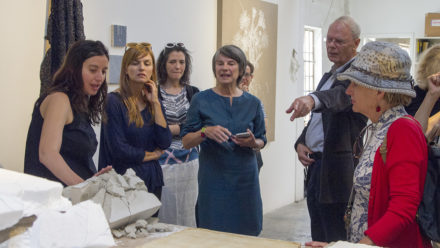
Drawing of Mexican antiquities (detail, color modified), Maximilian Franck, 1829. Trustees of the British Museum, Am2006, Drg.128
For three decades Los Angeles businessman Earl Stendahl was one of the world’s most influential dealers in pre-Hispanic art, using his genius for marketing to help shape museum and private collections in the US and Europe.
Recently donated to Getty, the archive of the Stendahl Galleries contains letters, photos, appraisals, and sales records that shed light on the sprawling 20th-century trade in Mexican and Central American antiquities. The new Pre-Hispanic Art Provenance Initiative will thoroughly study the archive and foster collaboration among institutions with complementary records, each of which holds missing pieces of the puzzle.
This work extends the Getty Research Institute’s decades-long commitment to provenance research, which has included comprehensive study of the early American art market, digitization and analysis of art sales records from 17th- and 18th-century Britain, and reconstruction of the Nazis’ movement of art during the Third Reich. The initiative is part of Ancient Worlds Now: A Future for the Past, a 10-year effort to address threats to pre-modern cultural heritage around the world.
Creating a Mania for Pre-Columbian Art
Earl Stendahl became the impresario of pre-Hispanic art almost by accident. He founded his L.A. gallery in 1911, and for years tried to interest buyers in European modernism. It wasn’t until the 1930s, when he tried his luck at Mexican antiquities, that he found his niche.
“He can’t sell modern art to California, but he strikes gold with pre-Columbian art: it’s figurative, it’s somewhat ‘primitive’ but not too much,” says Mary Miller, director of the Getty Research Institute and a scholar of Maya art.
The close of European shipping lanes in 1940 during World War II opened the floodgates for Stendahl. “Everyone’s looking for something new and fresh—and he’s got the inventory,” notes Miller. “Although he sells a few pieces in ‘39, starting in 1940 it’s gangbusters.”
Stendahl and his partners in Mexico not only did a brisk trade in antiquities—often looted, forged, or assembled from disparate fragments—but actively stoked demand for them among museums and collectors. “The world changes because of Stendahl,” says Miller. “There are other dealers, but Stendahl leverages his Hollywood connections to build the first mass market for pre-Columbian antiquities.” He supplied the May Company, for example, with a steady flow of Mexican antiquities that were sold in department stores.
Through his connections and marketing savvy, Stendahl helped change public perception of pre-Hispanic ceramics and stone carvings, elevating them from anthropological curiosities to works of fine art. Along the way, the objects he chose became the canon, shaping to this day how pre-Hispanic art history is written.

Earl Stendahl with pre-Hispanic sculptures, ca. 1950, Florence Homolka. Gelatin silver print. The Getty Research Institute, 2017.M.38. Gift of April and Ronald Dammann
The initiative’s project team will seek to uncover new insights not only about the art market for Mexican antiquities, but also about individual objects that passed through Stendahl’s hands. The dealer bought and sold objects from a range of cultures and time periods, and learning more about where these objects came from, and how they traveled, will shed light on the broader pre-Hispanic past.
“Our goal is to understand the trade in pre-Hispanic art as a cultural and art-historical story, but also an archeological and economic one,” Miller says. In the future, she hopes, the initiative will help researchers reassemble critical pieces of archaeology as well as reconstruct an important untold story about the economic relationship between Mexico and the United States.
The initiative launches this week with a free public lecture and daylong symposium featuring talks by scholars on the market for pre-Hispanic antiquities up to 1940.
Plans for future years include intensive scholarly collaboration, research publications, digital stories spotlighting the archive, digitization of key components of the archive, and additional conferences focusing on the years following 1940. The archive itself will be made available to researchers for consultation at the Getty Library once it has been processed and catalogued.
“There’s so much to do in terms of trying to understand the big picture of pre-Columbian art in the United States,” notes Miller. “The goal is really one of intellectual inquiry—trying to get the story straight.”




Comments on this post are now closed.